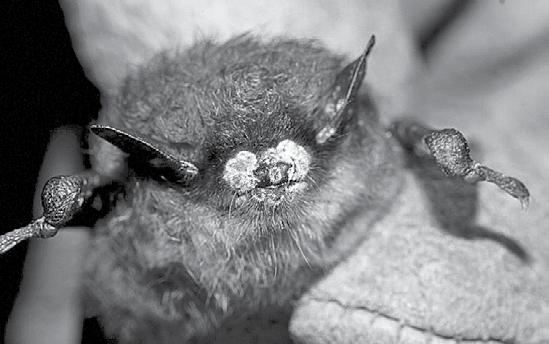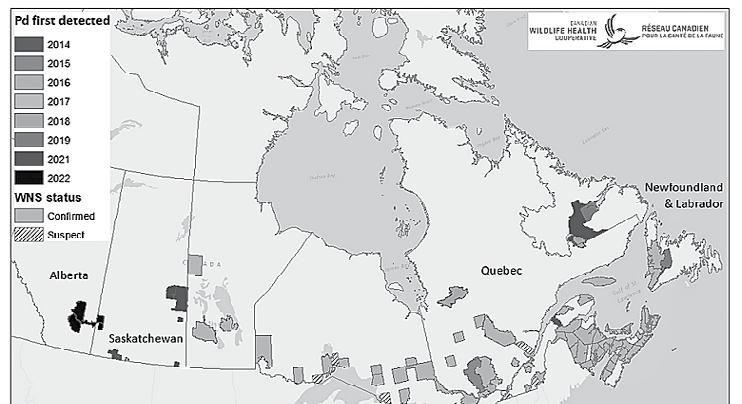
4 minute read
Bat Epidemic Spreads Into Alberta
from 977
Darcey Shyry
Submitted
Advertisement
The good news is that the bats in the maternity bat houses at Dillberry Lake Provincial Park on the Alberta-Saskatchewan border near Provost appear to be healthy and produced dozens of bat pups last summer! The unfortunate news is that a fungal disease (Pseudogymnoascus destructans) has now been positively detected in Alberta.
The fungus was found in bat guano (poop) collected by the Alberta Community Bat Program (ACBP), at bridges in Saskatchewan and Alberta during the summer of 2022. This fungus has confirmed along the Red Deer River, near Dinosaur Provincial Park. There are also likely, although presently unconfirmed, detections along the Beaver River, north of Bonnyville, and the Battle River, south of Lloydminster.
This fungal infection is called White Nose Syndrome (WNS) because heavily infected bats can get a “frosting” of white on their snouts. The damage to the bats can also be seen on wing and tail membranes by trained biologists. WNS has a terribly high mortality rate and has caused the entire loss of colonies of bats as it travels across North America from its introduction spots in New York State and Washington State.
WNS causes bats to arouse more frequently from hibernation. This causes them to burn energy warming their bodies, crawling around and even flying. That uncommon activity burns-off the fatreserves the bats need to survive the entire hibernation period.
Canadian bats cannot eat and replenish their energy stores in winter because they only eat insects, and there’s no insects available until spring.
Another threat to bats, particularly to the migratory bats that fly south (yes, like migratory birds), is the increasing number of wind turbines being installed for renewable energy production. It is not yet well understood, but it appears that these tall towers have an attraction for bats, which can increase the risk of collisions with turbine blades. Bats also can be killed if they are caught in the negative air pressure created behind rapidly spinning blades.
While there are promising treatments being tested that may one day provide a tool for combatting white-nose syndrome, currently the main priority is to minimize other sources of harm (roaming cats are a risk to bats) and ensuring they have healthy environments with roosting sites, hibernation sites and food available. Avoiding disturbances to hibernating bats and to maternity colonies are important for bat conservation and recovery.
Wind turbines are a new source of mortality for bats and can be particularly problematic for migratory bats like the hoary bat, but wind energy facilities have tools available to mitigate bat mortalities. For example, migratory bat mortalities at wind facilities can be mitigated by “feathering” (slowing-down) or lock- ing the rotor blades on warm nights with low winds during the bat migration period in fall. Although this mitigation can reduce energy production and revenue, bats typically don’t fly during high wind periods when wind turbines will have the greatest power output and revenues. Like the petroleum industry mitigating bird mortalities at tailings ponds, the wind industry also needs to mitigate wildlife mortalities to ensure compliance with federal and provincial wildlife conservation regulations.
Everyone knows that bats eat lots of pesky insects that interfere with our full enjoyment of outdoor spring and summer activities, but bats also eat crop pests and can reduce the need to use pesticides. Estimates of this non-toxic crop pest control (an Ecosystem Service) in the USA range from $3.7 to more than $53 billion dollars per year. Bats are valuable and important components of Canadian biodiversity and provide ecological services to people, nature and agriculture. It is very important to minimize bat deaths as much as possible because three species of bats in Canada are now Endangered and at risk of disappearing, and it is also very important to learn about them now before they disappear like they have in the east.
We need help finding bat colonies where we can sample for WNS by collecting guano and by swabbing bat houses and roosting sites. Wildlife Conservation Society Canada (WCS) focuses their efforts on conserving Canada’s growing list of wildlife species at risk. WCS is coordinating bat conservation in Alberta via the Alberta Community Bat Program. If you are interested in helping bats, helping track the spread of this bat disease into Alberta, and (very importantly) helping us collect information about our bats before they are gone, please contact:

Alberta Community Bat Program
Phone: 1-866-574-1706
Email: info@albertabats.ca
Darcey Shyry is a Professional Biologist and Regional Coordinator with the Alberta Community Bat Program. Darcey monitors the bat houses at Dillberry Lake and has a single bat that comes each July to his garagemounted bat house in Vermilion.
Village Of Myrnam
2023 Combined Assessment and Tax No�ce
Take no�ce that the combined tax and assessment no�ces were mailed to all property owners in the Village of Myrnam on Thursday, May 18, 2023. In accordance with Sec�on 311 of the Municipal Government Act, Chapter 26, RSA 2000, all persons are deemed to have received their combined tax and assessment no�ces as a result of this no�ce. The Assessment Roll is open for inspec�on at the Village Office, 5007 – 50th Street, Myrnam, Alberta, from 8:3012:00 and 1:00 - 3:30 p.m., Tuesday to Thursday at $5.00 per roll. If you disagree with the assessed value of your property, it is first recommended that you contact the Chief Administra�ve Officer to confirm the assessed value is correct. If the assessed value is correct, the next step is to contact the Village of Myrnam Assessor, Larry James of Wainwright Assessment Ltd., at 780-842-5002. If you disagree with the Assessor, and you wish to file complaint(s) to the Assessment Review Board, you must, by Tuesday, July 25, 2023, lodge your complaint(s) in wri�ng to the Clerk of The Assessment Review Board, Village of Myrnam – 5007 50th Street, Box 278 Myrnam, AB T0B 3K0, along with the appropriate fee ($50 Residen�al - $100 Non-Residen�al, Commercial). Your complaint must be completed on Assessment Review Complaint Form (LGS1402) which is available at the Village Office or online at h�ps://www.alberta.ca/property-assessment-complaints-andappeals.aspx. Forms that are incomplete, are submi�ed a�er the filing deadline, or are not accompanied with the fee will be considered invalid.
2023 Property taxes are due and payable on or before July 31st, 2023.
Elsie Kiziak, Chief Administra�ve Officer
5007 - 50TH STREET BOX 278
MYRNAM, ALBERTA T0B 3K0
PHONE: (780) 366-3910 admin@myrnam.ca FAX: (780) 366-2246










